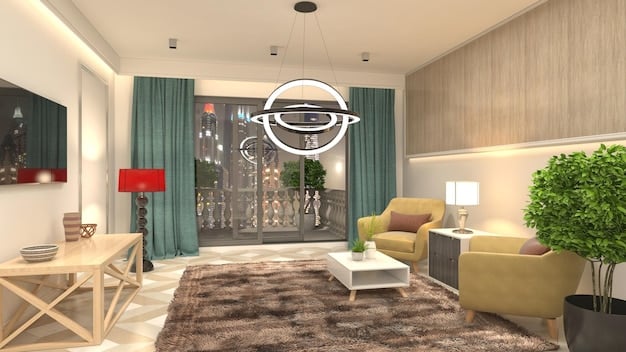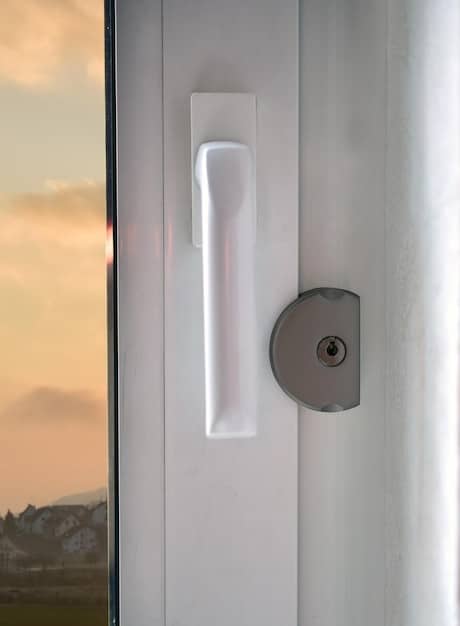Smart Home Security: Build Your Own Under $500 (2024 Guide)

Anúncios
Building a smart home security system under $500 in 2024 is achievable by strategically selecting affordable devices like security cameras, motion sensors, and smart locks, integrating them via a central hub for comprehensive protection.
Want to protect your home with advanced technology without breaking the bank? This practical guide shows you how to build a smart home security system for under $500 in 2024, offering a cost-effective way to enhance your peace of mind.
Anúncios
Understanding Your Security Needs
Before diving into the specifics of building your smart home security system, it’s essential to assess your individual needs and priorities. Every home is different, and a one-size-fits-all approach simply won’t do. Understanding your vulnerabilities will help you allocate your budget effectively.
Consider the size of your home, the number of entry points, the neighborhood crime rate, and any specific concerns you might have. Are you primarily worried about burglaries, package theft, or monitoring activity while you’re away? Answering these questions will guide your purchasing decisions.
Anúncios
Assessing Entry Points
Start by identifying all potential entry points to your home, including doors, windows, and even the garage. Evaluate the security of each entry point. Are your doors solid and equipped with sturdy locks? Are your windows easily accessible? Recognizing vulnerabilities is the first step toward securing them.
Identifying Vulnerabilities
Consider the layout of your property and any potential blind spots where intruders could approach undetected. Think about outdoor lighting, landscaping that might provide cover, and whether your property is easily visible from the street. These factors can influence your security strategy.
- Doors and Windows: Ensure all doors have deadbolt locks and reinforced frames. Consider adding window sensors that trigger an alarm if opened.
- Outdoor Areas: Install motion-activated lights to deter intruders. Trim bushes and trees that could provide cover.
- Garage Security: A smart garage door opener can alert you if the door is left open and allow you to close it remotely.
By thoroughly assessing your security needs and identifying vulnerabilities, you can create a targeted plan for building a smart home security system that effectively protects your property and stays within your $500 budget. Remember, a well-thought-out plan is the foundation of a secure home.
Choosing the Right Smart Home Hub
The heart of any smart home security system is the smart home hub. It acts as a central control point, connecting all your smart devices and allowing them to communicate with each other. When choosing a hub, compatibility, ease of use, and cost are important factors to consider.
While some advanced hubs can be expensive, several affordable options offer a robust set of features and support a wide range of devices. Researching different hubs and understanding their capabilities is crucial to making the right choice for your needs.

Popular Hub Options
Several affordable smart home hubs are readily available and offer excellent functionality. These hubs often support popular protocols like Zigbee and Z-Wave, ensuring compatibility with a wide array of smart devices.
Some hubs also offer voice control integration with Amazon Alexa or Google Assistant, allowing you to arm and disarm your system with simple voice commands.
- Amazon Echo (4th Gen): Offers built-in Zigbee support and voice control via Alexa.
- Google Nest Hub (2nd Gen): Integrates with Google Assistant and supports Matter, a new interoperability standard.
- Samsung SmartThings Hub: Compatible with a wide range of devices via Zigbee, Z-Wave, and Wi-Fi.
Selecting the right smart home hub is a critical step in building your budget-friendly security system. Consider the features, compatibility, and ease of use of each hub to ensure it meets your specific needs and integrates seamlessly with your chosen devices. With the right hub in place, you’ll be well on your way to creating a secure and connected home.
Selecting Essential Security Devices
With a smart home hub in place, the next step is to select the essential security devices that will form the core of your system. These devices typically include security cameras, motion sensors, and smart locks. Prioritizing devices that offer the best value for your budget is key.
Consider focusing on a few high-quality devices that address your most pressing security concerns, rather than spreading your budget too thin across multiple less effective options. A strategic approach will ensure you get the most security for your money.
Security Cameras
Security cameras are a crucial component of any smart home security system. They provide visual monitoring of your property and can deter potential intruders. When choosing cameras, consider factors such as video resolution, field of view, night vision, and weather resistance.
Many affordable security cameras offer excellent features, including motion detection, two-way audio, and cloud storage options. Look for cameras that are easy to install and integrate seamlessly with your chosen smart home hub.
Motion Sensors
Motion sensors are another essential device for detecting unauthorized activity. They can be placed near entry points, in hallways, or in other areas of your home to trigger an alarm or send a notification when motion is detected.
Choose motion sensors that are reliable, easy to install, and offer adjustable sensitivity settings to minimize false alarms. Some motion sensors can also be integrated with other smart devices, such as lights, to create a more comprehensive security system.
Selecting the right security devices is crucial for building an effective and budget-friendly smart home security system. By carefully considering your needs and prioritizing essential features, you can create a system that provides comprehensive protection without breaking the bank. With the right devices in place, you can enjoy greater peace of mind knowing your home is secure.
Integrating Smart Locks for Enhanced Security
Smart locks offer a significant upgrade over traditional locks, providing enhanced security and convenience. They allow you to control access to your home remotely, track who enters and exits, and even create temporary access codes for guests or service providers.
While some high-end smart locks can be quite expensive, several affordable options offer excellent features and integration with popular smart home platforms. Consider your specific needs and budget when choosing a smart lock for your system.

Benefits of Smart Locks
Smart locks offer a range of benefits that can significantly enhance your home security. They provide greater control over who has access to your home and allow you to monitor entry and exit activity in real-time.
Some smart locks also offer advanced features such as tamper alerts, which notify you if someone attempts to force the lock. Additionally, many smart locks can be integrated with other smart home devices, such as lights and security cameras, to create a more comprehensive security system.
Affordable Smart Lock Options
Several affordable smart lock options are available that offer excellent features without breaking the bank. These locks typically connect to your smart home hub via Bluetooth or Wi-Fi and can be controlled remotely via a smartphone app.
When choosing a smart lock, consider factors such as ease of installation, battery life, and compatibility with your existing door hardware. Look for locks that offer robust security features, such as encrypted communication and tamper resistance.
- Wyze Lock: An affordable option that integrates with Wyze’s ecosystem of smart home devices.
- Kwikset SmartCode: Offers keyless entry and remote access features.
- Schlage Encode: A Wi-Fi enabled smart lock that integrates with Alexa and Google Assistant.
Integrating a smart lock into your home security system can provide enhanced security and convenience. By carefully considering your needs and budget, you can choose a smart lock that offers the features you need without exceeding your $500 budget. With a smart lock in place, you can enjoy greater peace of mind knowing your home is more secure.
Setting Up Notifications and Alerts
A crucial aspect of any smart home security system is the ability to receive timely notifications and alerts when potential security events occur. These alerts can notify you of motion detection, door or window openings, or other suspicious activity, allowing you to take immediate action.
Configuring notifications and alerts correctly is essential to ensure you are promptly informed of any potential threats. Customize your notification settings to receive only the alerts that are most important to you, minimizing false alarms and distractions.
Customizing Alert Settings
Most smart home security systems allow you to customize the types of alerts you receive and the conditions under which they are triggered. Take advantage of these settings to tailor your alerts to your specific needs and preferences.
For example, you might choose to receive alerts only during certain times of day, such as when you are away from home or during nighttime hours. You can also adjust the sensitivity of motion sensors to minimize false alarms caused by pets or other non-threatening sources.
By carefully configuring your notification settings, you can ensure that you are promptly informed of any potential security threats without being overwhelmed by unnecessary alerts. This will allow you to respond quickly and effectively to any potential security breaches.
Testing and Maintaining Your System
Once you have set up your smart home security system, it’s essential to test it thoroughly to ensure that all devices are working correctly and that notifications are being received as expected. Regular testing and maintenance will help you identify and address any potential issues before they compromise your security.
Schedule regular testing sessions to verify that all sensors, cameras, and locks are functioning properly. Check the battery levels of wireless devices and replace batteries as needed. Also, review your notification settings to ensure they are still configured correctly.
Regular Maintenance Tasks
In addition to testing your system, perform regular maintenance tasks to keep your smart home security system in top condition. These tasks may include cleaning camera lenses, updating firmware, and reviewing security logs.
Keep your smart home hub and security devices updated with the latest firmware to ensure they have the latest security patches and bug fixes. Regularly review your security logs to identify any unusual activity or potential security breaches. Also, change your passwords periodically to prevent unauthorized access to your system.
- Check Device Batteries: Replace batteries in wireless devices regularly to ensure uninterrupted operation.
- Update Firmware: Keep your smart home hub and security devices updated with the latest firmware for security patches and bug fixes.
- Review Security Logs: Monitor your system’s security logs for any unusual activity or potential security breaches.
By testing and maintaining your smart home security system regularly, you can ensure that it remains effective and reliable in protecting your home and family. Consistent maintenance will help you identify and address any potential issues before they compromise your security.
| Key Point | Brief Description |
|---|---|
| 💡 Assess Needs | Identify vulnerabilities to target your security efforts effectively. |
| 🏠 Choose Hub | Select a compatible smart home hub to connect all your devices. |
| 🔒 Security Devices | Prioritize essential devices like cameras, sensors, and smart locks. |
| 🔔 Setup Alerts | Configure notifications to stay informed about potential security events. |
FAQ
▼
Yes, by choosing affordable devices and focusing on essential features, a comprehensive system is achievable. Prioritize key components like cameras and sensors.
▼
Security cameras are crucial because they provide visual monitoring, deter intruders, and offer evidence in case of a security breach.
▼
Adjust the sensitivity settings on your motion sensors and strategically place them to avoid triggers from pets or environmental factors.
▼
No, most devices are designed for DIY installation, making setup straightforward. Ensure you follow the manufacturer’s instructions carefully for optimal performance.
▼
It’s recommended to test your system at least once a month to ensure all components are functioning correctly and notifications are being received promptly.
Conclusion
Building a smart home security system under $500 in 2024 is not only feasible but also a smart investment for your peace of mind. By carefully assessing your needs, choosing the right devices, and configuring your system effectively, you can create a cost-effective security solution that protects your home and family.





